Nanjing people look at Nanjing-Linggu Temple in autumn
Red maple in autumn

Crossing the Yingjia Bridge is the Wangong Pool. The Wangong Pool in autumn is colorful.

Wangongchi is facing the Red Mountain Gate of the "Linggu Shengjing". The gate is a three-arched foyer. The middle gate is inscribed with the title "Linggu Shengjing" and is covered with green glazed tiles and red walls on both sides.

There is a red wall and a side door on both sides of the gate, each with the books "Song Song" and "Quan Tao".

Entering from Hongshanmen is the central axis of the scenic area, all the way north. The tall pines on both sides are still strong green.

Above the 42 steps is a reinforced concrete memorial archway.

Under the blue sky and white clouds, the archway topped by green glazed tiles is spectacular.

There are two stone beasts on the left and right of the archway.

The vegetation in Linggu Temple occupies a large area. In late autumn, the colors of the plants are rich.

The mottled light and shadow generated by the sun passing through the dense forest sprinkled on the ancient buildings with a mysterious color.

Pick up a ginkgo leaf to add a small prospect to the archway

Looking to the north side under the archway, there is the Wuliang Hall at the end of the central axis.
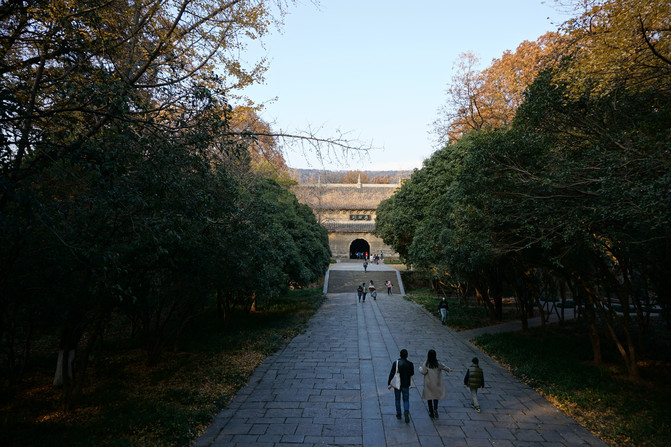
The rich vegetation in the scenic area sets off the ancient buildings to make them majestic, majestic and heroic.

A turtle is waiting here in the forest

If you look carefully, you will find that you look lifelike. How many stories are hidden in the century-old waiting.
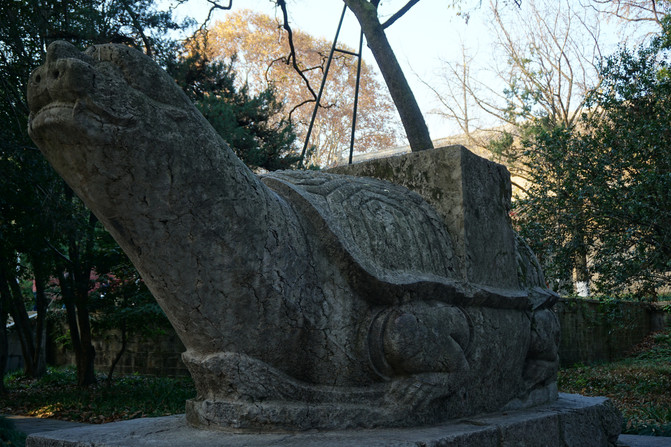
In autumn, under the light and shadow, the color of the buildings and the color of the rich vegetation provide a picture of autumn charm with full artistic conception

The Wuliang Hall is made of bricks from the base to the top, without even an inch of wood. It is a masterpiece of ancient stone architecture in our country.

The square in front of the temple is rich in vegetation and artistic.

There are six tall ginkgo trees in front of the hall.

Maple trees are lined up on the east and west sides of the square.

These low red maples attract tourists to pose here

Give a close-up of these beautiful leaves


Looking at the archway from Wuliang Hall

Tall trees in the dense forest have various colored leaves, and the ground is covered with various colored leaves


The ground is golden

The leaves on a tree are all colorful

Coming out of the Wuliang Hall is a semicircular flower-bed lawn with a wide view-Cemetery No. 1. When the cemetery was built, a semicircular wall hundreds of meters long was adopted, with curved undulating shapes, like Nanjing's city flower-plum blossoms. It is quite a combination of Chinese and Western styles. Now the cemetery has become a flower bed with diverse vegetation.

The diverse vegetation shows rich colors in late autumn. These differently colored branches and leaves are like colorful brushes painting the canvas.

On one side is the Linggu Temple, which has a lot of incense. Yellow walls and black tiles, lush pines and lush forests, and a quiet environment. Inside this round door is Linggu Temple Suzhai Hall.

Bypass the wall of Cemetery No. 1 and see Songfeng Pavilion. It is a palace-like building. The roof is made of glazed tiles, and the "Pine Wind Pavilion" hangs from the eaves. Diaoliang beams and painted buildings, and the colorful Songfeng Pavilion stands high above.

Go up the steps, bypass Songfeng Pavilion, and take a photo of your back.

A tripod and a tower are in front of you

The tower is still the same tower, but the same scenery will produce different effects due to different seasons and different vegetation colors.
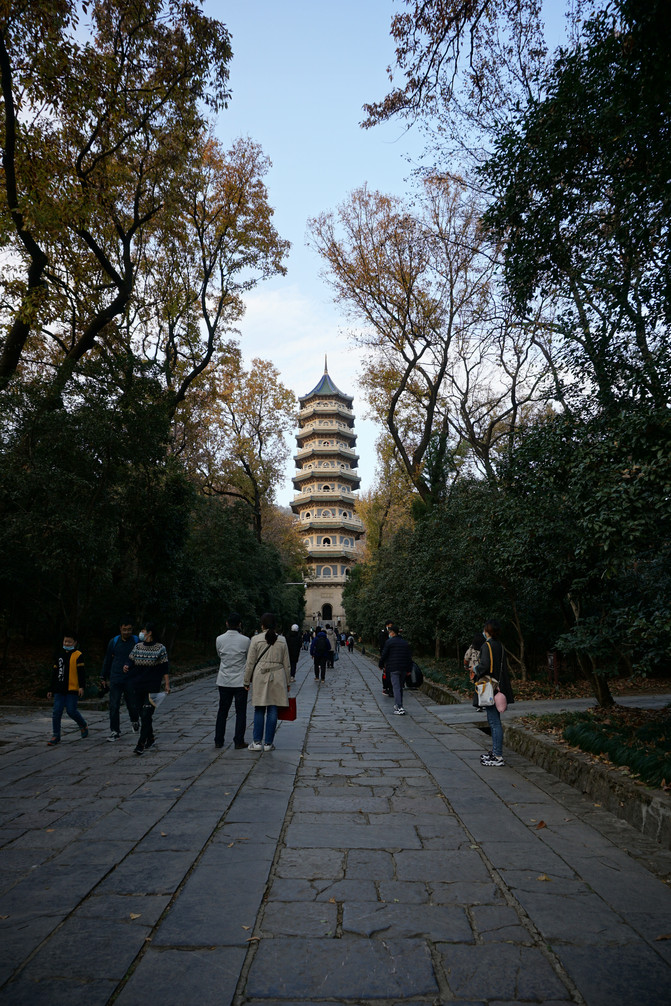
Linggu Tower shines brightly in the sun

Linggu Tower, which is made of steel-concrete and granite, has a pavilion tower style.

The whole tower is beautiful in shape, solid and steady, surrounded by carved stone railings with cloud heads, green and white, shining with golden light, piercing the blue sky.

On the front lintel of the first floor of the tower, the three gilded characters "Linggu Tower" are engraved in regular script

Enter the tower from the main entrance. There is a spiral escalator built in the middle of the tower, which can follow the 252 steps of the ladder to reach the ninth floor.

From the second to the ninth floors, there are several door openings leading to the fence in each circle of the tower.

On each floor, you can stop by the bars to see the scenery, because the same scenery forms different landscapes at different altitudes.

On the second floor of the tower, you can see the beauty of autumn colors because of their rich and intense colors. Under the sun, the mountains and forests are rolling like golden waves.
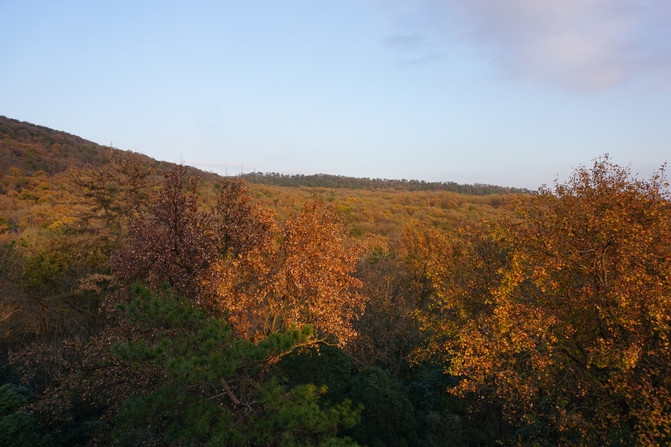
The mountains and forests are everywhere, and you can see the confrontation between deep red and gold from every angle.

Continuing to spiral up the spiral ladder, the picture of the mountains and forests in autumn is really shocking
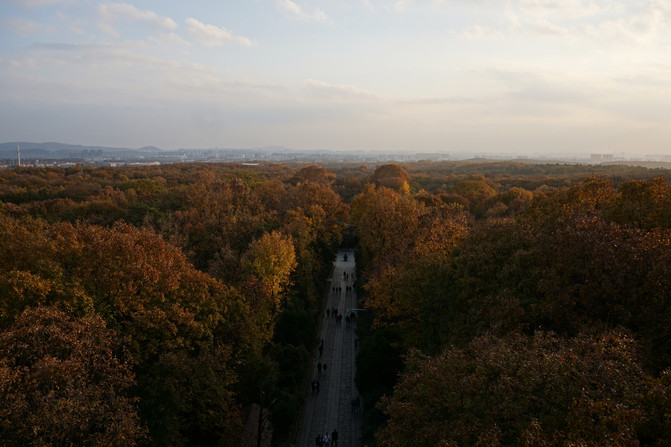
Being in it, the drunk autumn scenery fills the mountains and forests. The Linggu Temple Scenic Area, which is soaked by autumn light, is plated with a layer of soft warm light

There are several door openings around the tower that lead to the fence, so sunlight can often reflect from one door opening to another door opening, creating a magical atmosphere.

Overlooking the rolling forest, beyond the forest is Nanjing's skyline.

In the soft undulations of the mountains, various vegetation intertwine, each showing its own beauty, and cluster each other on the hillside. It is impossible to distinguish the background color from the main color, and it is beautiful.

The Maqun area on the southeast side of the mountain forest is already full of high-rise buildings.

The sunset is like a magician. As the clouds change, light and shadow flow, and the colors of the mountains and forests are also changing. One moment it is yellow and green, and the next moment it is red and yellow.
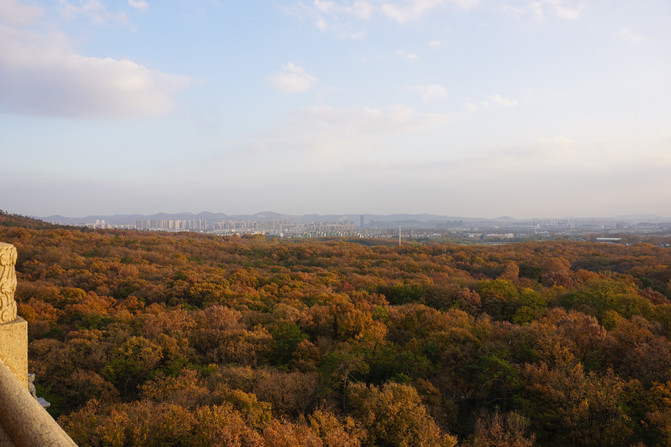
Colorful, autumn colors make the mountains and forests beautiful.

There is a fence on each floor that allows us to face the pictures of the mountains and plains covered by forests. The imagined colorful oil painting world is nothing more than this.

The flying beasts with eaves on each floor have been silently waiting on this land, watching the alternating cycle of the mountains and forests from green to dark green to golden and brown-red.


It is sunny in autumn, and there are many tourists today. There are tourists stopping to enjoy the beauty on every floor

Many enthusiasts with long guns and short cannons are here to wait for the sunset.

There are also women quietly waiting for the beautiful scenery

On the west side of the tower, among the layers of Purple Gold Mountains, the one closest to my blue-yellow glazed tiles is the Sutra Tower. The gray-blue Sun Yat-sen Mausoleum above the mountain range in the middle, and the farthest and highest mountain-top observatory can be seen in all directions. The Zifeng Building is very recognizable in the urban scenery along the mountains.

The silhouette of the city on the west side of the mountains is hazy and romantic in the sunset

The changes in the sun and clouds make the picture changeable, but no matter what, it is beautiful.





Lying on the fence and looking straight at it, facing the front of the tower body is the central axis of the Linggu Temple Scenic Area.

Starting from the gate of the scenic area, I followed the rich and colorful autumn colors and headed straight to the top of the tower along the central axis. Wangongchi-Hongshanmen-Memorial Arch of the Dead Soldiers-Wuliang Hall-Cemetery of the Dead Soldiers-Songfeng Pavilion-Linggu Tower, the thick autumn along the way makes people deeply intoxicated.

The mountains and forests under the sunset and the city under the sunset have the charm of dusk and autumn.

Watch the sunset from the top of the tower, and go down to see more colors while the sun is still wandering in the horizon.

Bypass Songfeng Pavilion and come to the tomb path of Tan Yankai's tomb on the east side of Linggu Temple. Tan Yankai's tomb consists of four parts. I did not continue north to the square, memorial hall and tomb chamber, but walked south along the tomb path.

Although Linggu Temple is not as red as the mountains and plains of Qixia Mountain, there is inadvertently a warm scene of red maples like fire in the entire scenic area.

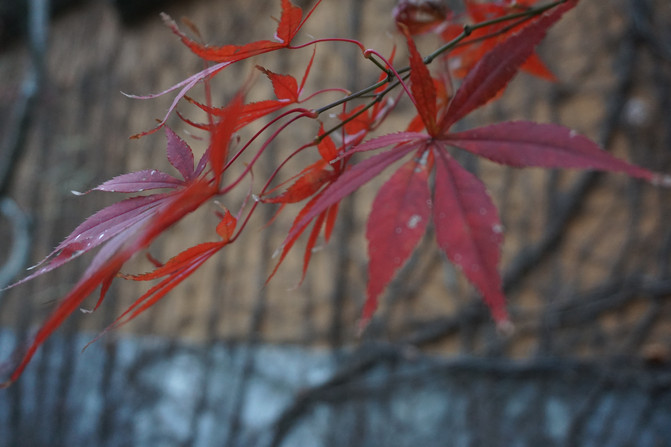
The wall on the east side of the temple is covered with creeper. The creeper and the ancient tree shade each other, gently embracing the temple. At this time, the creeper, which had already lost its leaves, looked vigorous and powerful. It matched the red maple in front of it, making the red brighter and a natural contrast.

Yellow walls, blue sky, lonely branches

The slender and tenacious creeper is the vitality of late autumn, desolate and powerful.
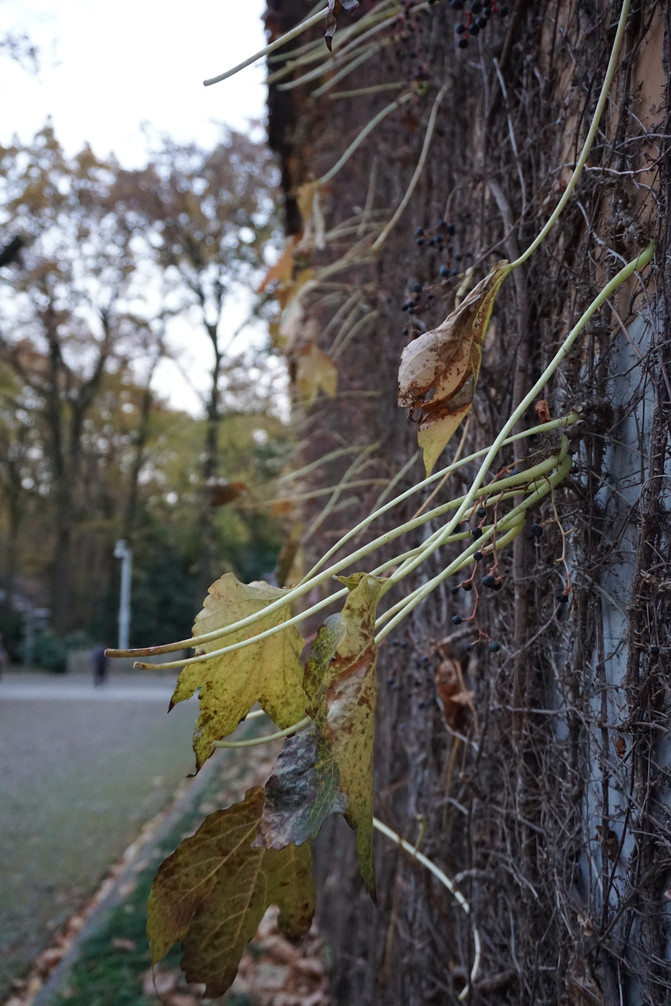
The leaves return to the soil in late autumn, and only the tenacious stems are still tightly attached there, waiting for the growth of the next year's leaves.

A South Lake stone archway stands tall under the towering ancient trees,

There is a strong sense of tranquility here as a winding path leads to the tranquility.

There is a stele 20 meters south of the archway. The stele is surrounded by stone guardrails. The stele reads "Deep Pine in Linggu." In fact, this monument is the tombstone of Tan Yankai, former Chairman of the National Government and Premier of the Executive Yuan. On it, there were original words inscribed by Chiang Kai-shek,"Tomb of Tan Gongyan, Executive Member of the Central Committee of the Kuomintang Party of China and Former Chairman of the National Government of the Communist Party of China," which was rewritten after 1949. However, the four words "Linggu Deep Pines" really reflect the environment and atmosphere in which the monument is located. The surrounding area is lush with green pines and cypresses. Behind the monument pool is the corridor leading to Tan Yankai's cemetery.

There is a stream running from north to south on the east side of the corridor. The fallen leaves in a pool are so beautiful, a kind of lonely beauty.

The quiet Linggu Temple reflects the ancient charm of the temple amidst the charm of autumn

Turn right on the tunnel and you will find the main entrance of Linggu Temple. Yellow walls, black tiles and red pillars, lush pine trees, and a quiet environment.

Today, I suddenly discovered a huge ginkgo tree here.

Why don't I have any impression of this huge ancient ginkgo tree? I come to Linggu Temple every year. Why did I discover this ginkgo tree this time? If it had not been transplanted before, it would be fine. What would it mean if it existed before and I have been ignoring it until I suddenly discovered its existence today?

The Temple of Wealth under the Ancient Ginkgo biloba

Linggu Temple is even more charming amidst the charm of autumn.

The epidemic in recent years has made it impossible for us to hike. Fortunately, Nanjing is a beautiful city that you don't have to go out. As long as you have the heart, Nanjing is full of beautiful scenery.
Previous Article:A preliminary study of Jiangsu Garden Expo Park--The final chapter
Next Article:Nanjing people look at Nanjing--waiting for the sunset in Yuzui Wetland Park
